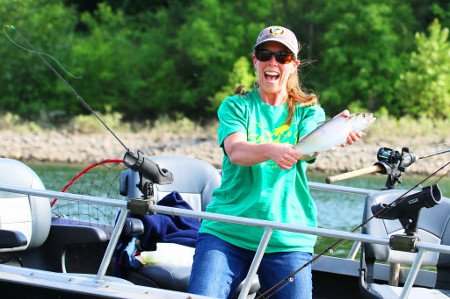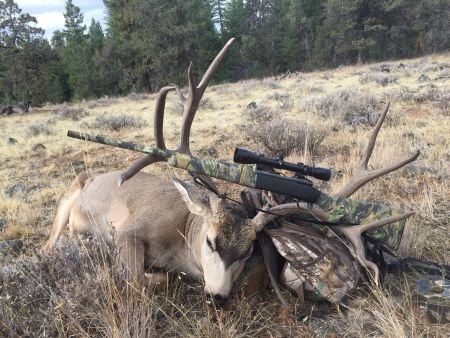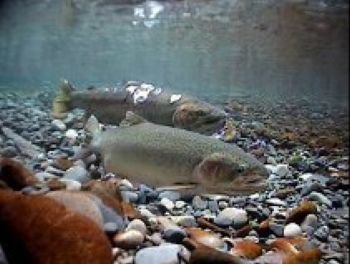Shed Hunting Do It Responsibly to Protect Big Game
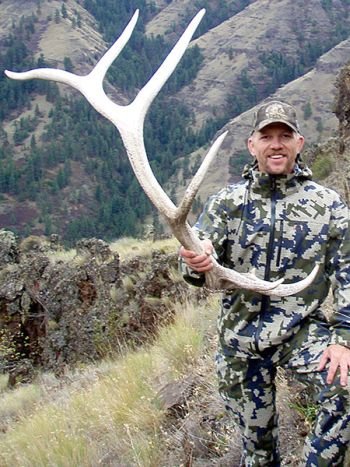
(SALEM, Ore) — This time of year isn’t just for Easter egg hunting. Many Oregonians are in the outdoors looking for another seasonal treat– shed antlers.
Oregon’s male deer and elk naturally shed their antlers at this time of year (only to regrow them in spring and summer). Buck deer usually shed theirs from late December through March, and bull elk from late February through early April.
Rob Tanner, co-founder of Oregon Shed Hunters, believes more people are enjoying the sport of shed hunting. “We are noticing more people getting out, but the clientele has changed a bit,” he says. “It’s no longer just hardcore hunters; nowadays it’s more of a family event with mom, dad, kids and even pets out shed hunting.”
But the peak of shed hunting season in late winter/early spring also coincides with tougher weather and less forage availability for big game, making it a vulnerable time for wildlife. Shed hunters using motor vehicles can put wildlife on the move when these animals need to be conserving valuable energy reserves. Pets and people on foot or horseback can also disturb big game.
Wildlife biologists have real concerns about the sport’s impact on big game, especially when it’s not practiced responsibly. “Shed hunters and their dogs can pressure, stress and exclude deer from the very ground that was set aside to help them survive the winter,” said Chase Brown, assistant district wildlife biologist in The Dalles.
While this year’s mild winter has made conditions easier for big game, it could also mean they get disturbed more than usual. “The mild winter had made access easy this year, so shed hunters can go into more remote places,” says Mark Kirsch, Umatilla District wildlife biologist. Kirsch cites resource damage (from vehicles using unimproved roads or going cross country), gates left open, trespassing and movement of animals to private agricultural land where they cause damage as some common problems seen from unethical shed hunting.
Shed hunters can take the following steps to protect big game while still enjoying their sport:
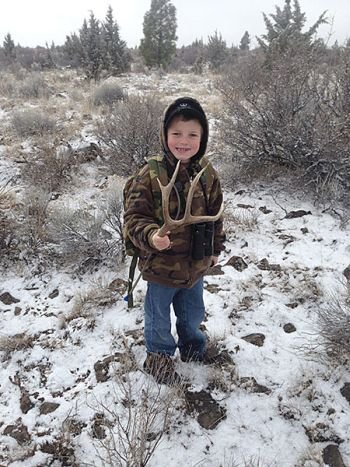
- Don’t disturb big game animals: Don’t approach animals or follow the same ones on a daily basis.
- Respect road and area closures. These are in place to protect winter range and wintering big game. Some ODFW wildlife areas are entirely closed to public access during late winter; other areas have road and travel restrictions. More information on specific closures below or see the 2015 Oregon Big Game Regulations.
- Don’t take vehicles off-roading. The ground is water-logged at this time of year and off-roading in the wrong place can damage critical wildlife and fish habitat. Travel by foot or horseback instead.
- Don’t be in the same spot every day. Deer and elk might need to be in that spot for food or cover, and your presence will keep them from it.
- Keep dogs under your control. Don’t let dogs approach or follow wildlife. State law prohibits dogs (and people) from harassing wildlife. (ORS 498.102 and 498.006)
- Don’t trespass on private property. You always need permission to be on private land. Antlers that are shed on private land below to the landowner under Oregon statutes.
Monitoring winter range closures and travel restrictions are a priority for Oregon State Police at this time of year. OSP patrols winter range closures and travel management areas by air and by vehicle.
More about antlers
Antlers are the fastest-growing bone that isn’t cancerous or prenatal. Antlers on deer can grow at a rate up to seven times that of skeletal growth. Elk antlers can weigh 30-40 pounds.
Elk antlers begin re-growing soon after they are shed, with most growth happening in spring and summer months. The antlers are covered by “velvet” throughout this growth period, before hardening to bone in late July-early August for elk and late August-early September for deer. This makes antlers ready in time for breeding season (in September for elk and November for deer), when male deer or elk will fight for dominance using their antlers.
Oregon Big Game Regulations (page 22) state that “No person shall possess or transport any game mammal or part thereof which has been illegally killed, found or killed for humane reasons, except shed antlers, unless they have notified and received permission from personnel of the Oregon State Police or ODFW prior to transporting.” So people may pick up naturally shed antlers in the outdoors, but may not pick up skulls with antlers attached without permission.
People who collect shed antlers are allowed to sell or exchange them, but certain rules apply. Only naturally shed antlers, antlers detached from the skull, or a skull split apart can be sold or exchanged. For antlers detached from the skull or skulls split apart, the seller must have legally taken the game part (e.g. on a big game tag or after receiving permission from OSP or ODFW to remove skull and antlers from the wild in the first place.)
Past poaching problems led to the regulations. Skulls that are split have less value and are not eligible for record books. These regulations reduce the incentive for someone to kill animals on winter range or out of season, hide the skull, and go back months later and “find it”. A Hide/Antler Dealer permit ($17) is needed to purchase antlers for use in the manufacture of handcrafted items.
Road closures and other regulations
Several ODFW managed wildlife areas and Travel Management Areas are closed during the winter to protect big game on winter range. Others have travel restrictions. See page 80-85 of the 2015 Oregon Big Game Regulations for more information.
Wildlife Area closures;
- Phillip W Schneider Wildlife Area (Dayville): Closed to public access Feb. 1 - April 14, some roads closed seasonally from Dec. 1-April 14.
- Elkhorn Wildlife Area (Baker and Union Counties): Closed to public access Dec. 1 - April 10.
- Bridge Creek Wildlife Area (near Ukiah): Closed to public access Dec. 1 - April 14.
- Jewell Meadows Wildlife Area (Clatsop County): Refuge and area closures.
- Ladd Marsh Wildlife Area (La Grande): Lands west of Foothill Road closed to entry Feb. 1 - March 31.
- Prineville Reservoir Wildlife Area (Maury and Ochoco Units): Closed to motorized vehicle access Nov. 15 or Dec. 1-April 15.
- White River Wildlife Area (Wamic): Road closures and restrictions.
Other winter range closures (See map of wildlife management units)
- Lost River Winter Range (Klamath Falls Unit): Closed to motor vehicle use Dec. 1 – April 15.
- Bryant Mt (Klamath Falls Unit): Closed to motor vehicle use Nov. 1 - April 15.
- Tumalo Winter Range (Upper Deschutes Unit): Closed to all motor vehicle use Dec. 1 - March 31.
- Cabin Lake-Silver Lake Winter Range (Paulina, Silver Lake, Fort Rock Units): Closed to motor vehicle use Dec. 1 - March 31.
- Metolius Winter Range (Metolius Unit): Closed to motor vehicle use Dec. 1 - March 31.
- Starkey Experimental Forest Enclosure (Starkey Unit): Closed to all public entry Nov. 15 - April 30.
- Spring Creek Winter Range (Starkey Unit): Closed to all motor vehicle use Dec. 15 - April 30.
- McCarty Winter Range (Starkey Unit): Closed to all motor vehicle use Dec. 15 - March 31.
